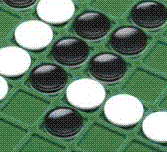
The modern version is based on the game reversi that was invented in 1883 by Englishmen Lewis Waterman in 1888. It enjoyed a brief flare of popularity, then faded into obscurity until it was resurrected in England at the end of the 19th century as Othello. In 1893, the German games publisher Ravensburger started producing the game. The modern rule set used on the international tournament stage originated in Mito, Ibaraki, Japan in the 1970s: the Japanese game company Tsukuda Original registered the game under the trademark name Othello. Goro Hasegawa, who wrote How to win at Othello, popularized the game in Japan in 1975.